ISSN ONLINE(2278-8875) PRINT (2320-3765)
ISSN ONLINE(2278-8875) PRINT (2320-3765)
J.P.SHRI THARANYAA1, A.JAGADEESAN 2 , A.LAVANYA 3
|
| Related article at Pubmed, Scholar Google |
Visit for more related articles at International Journal of Advanced Research in Electrical, Electronics and Instrumentation Engineering
In urban areas the water supply to residence and commercial establishments are provided at a fixed flow rate. There are incidents of excess water drawing by certain customers/users by connecting motor-pump sets to the water lines which is considered as water theft. In this project it is proposed to develop an embedded based remote water monitoring and theft prevention system by recording the flow rates at the consumer/user end. In order to implement the proposed water supply system, each consumer end should be provided with an embedded based water flow monitoring system consisting of a microcontroller to record the flow rate using a flow sensor and to transmit the same to a remote monitoring station using wireless transmitter and it is also provided with an electrically operated solenoid valve to supply water to the consumers. The valve turns on/off by the central processing station PC to stop the water supply whenever the flow rate exceed a predefined limit. It is proposed to employ a GSM MODEM for wireless communication so that the information can be passed to many responsible officers cell phone for immediate action.
Keywords |
| Flow sensor, solenoid valve, GSM modem. |
INTRODUCTION |
| With the continuous economic growth, the water demand of enterprises is also increasing. The monitoring of water resource for these enterprises can prevent the occurrence of stealing water and leaking water effectively. Therefore, the monitoring system of urban water supply has aroused extensive attention in recent years. Urban water supply networks form the link between drinking water supply and drinking water consumers. These large-scale networks are vital for the survival of urban life, for maintaining a healthy level of economic development, and for the continuous operation of factories and hospitals. |
| In world, urban water supply systems are public enterprises, usually part of a local government, and the recent increased interest in privatizing public enterprises has not led to reforms of water systems. Nevertheless, in about 50 cities in the developing world, the water system either has been privatized or franchised to a non-governmental entity for its operation and maintenance. |
| In this research work it is proposed to develop an embedded based remote water monitoring and theft prevention system by recording the flow rates at the consumer/user end. In order to implement the proposed water supply system, each consumer end should be provided with an embedded based water flow monitoring system consisting of a microcontroller to record the flow rate using a flow sensor and to transmit the same to a remote monitoring station using wireless transmitter. |
| With the rapid development of global system mobile infrastructure and information communication technology in the past few decades has made the communication is reliable for transmitting and receiving information efficiently. So here we used GSM modem for efficient communication purpose. A design is based on RF and Zigbee which has some shortcomings, such as high power consumption, near distance and network's size is small. So, GSM is chosen in this project. |
| In the high-end applications of embedded system, ARM company has introduced a 32-bit ARM family which includes ARM7, ARM9, ARM9E, ARM10E, ARM11 and so on. Where, the ARM7 has some advantages, such as running the μC/OS-II embedded operating and low cost and so on. So it can meet the design's requirements of this system fully. Therefore, in hardware design this system uses ARM7 as the main chip. |
II. EXISTING SYSTEM |
| The water supply systems are part of the urban infrastructure which must assure the continuity of the water distribution, the water quality control and the monitoring and control of the technological process parameters, and deal with the restrictions imposed by the water availability, hydrological conditions, the storage capacity of the tanks and water towers and the increasing diversity of water use. |
| In existing system, urban water is supplied to the home with the help of some man power. The person in charge will go to the place and then open the valve to that particular area. Once the time is over the person will go again to that place and close the valve. This type of operation needs man power. This is waste of time to go to that place and come back often. Also the people may take excess water for their personal use with the help of motor or some other equipment. Due to this many people will not receive sufficient water for their use. |
| Water is the basic needs of the humans. So it should be supplied properly and at right time. The theft can be prevented only when any public inform the officials about the theft. But the possibility of public is informing to higher officers are rare. So the theft prevention or one who does the theft is difficult to identify in the early methods. |
III. PROPOSED SYSTEM |
| In this research work, it is proposed that the usage of Anti-theft control system for drinking water supply. By implementing this proposed system in a real time; surely it will be able to control the drinking water theft in the domestic areas. In urban areas the water supply to residence and commercial establishments are provided at a fixed flow rate. There are incidents of excess water drawing by certain customers/users by connecting motor-pump sets to the water lines which is considered as water theft. The pipeline arrangement is shown in Fig. 1. |
| In this work, it is proposed to develop an embedded based remote water monitoring and theft prevention system by recording the flow rates at the consumer/user end. In order to implement the proposed water supply system, each consumer end should be provided with an embedded based water flow monitoring system consisting of a microcontroller to record the flow rate using a flow sensor and to transmit the same to a remote monitoring station using wireless transmitter. |
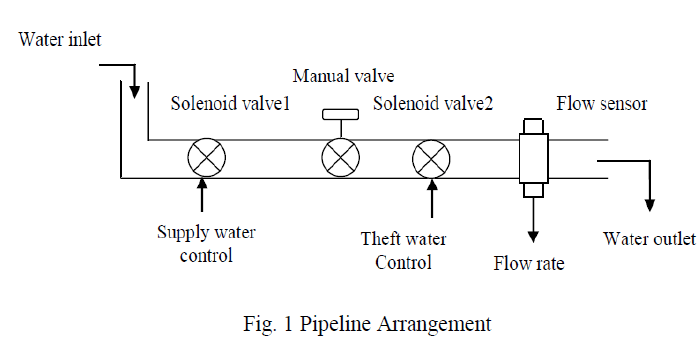 |
| The system is provided with an electrically operated solenoid valve to supply water to the consumers. The valve turns on/off by the central processing station PC to supply the water for a particular time period. The system is provided with an electrically operated solenoid valve to stop the water supply whenever the flow rate exceeds a predefined limit. The microcontroller will switch ON/OFF the solenoid valve using a TRAIC switch. It is proposed to employ a GSM MODEM for wireless communication so that the information can be passed to many responsible officers cell phone for immediate action. |
IV. SYSTEM DESCRIPTION |
| The flow rate is sensed by the signal conditioning unit when the water is passed through the pipeline. The sensor operates under certain predefined value. When there is a variation in the water flow due to any pumping of water through motor, it will be detected by the water flow sensor. |
| The signal conditioning unit is used to give the desired input signal of the ADC. The analog signals generated due to variation in the flow of water sensed by the water flow sensor are converted into digital signals using Analog to Digital Convertor (ADC) and this digital signal is given to Microcontroller. This microcontroller enables the transmitter signal for intimate to water supply board. At the same time they enable the driver unit to closes the solenoid valve. |
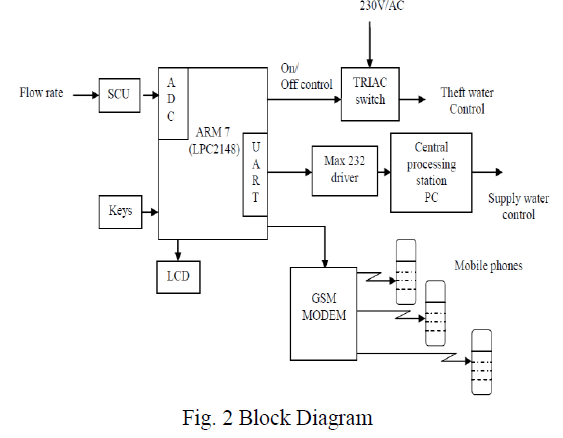 |
| The microcontroller is don’t have the capability for driving the solenoid valve. So here it was designed the driving circuit using TRAIC to operate the solenoid valve for ON/OFF control. The flow rate conditions are displayed by the PC. Then here we proposed GSM MODEM for wireless communication so that the information can be passed to many responsible officers cell phone for immediate action. |
| The communication is done with help of MAX232 IC between the microcontroller and PC. To communicate over UART or USART, we just need three basic signals which are namely, rxd (receive), txd (transmit), gnd (common ground). So it is interface MAX232 with any microcontroller. |
| The components of the system are |
| A. Flow Sensor |
| The flow sensor is relatively simple liquid flow thro’ the pipeline impinges upon the turbine blades which are free to rotate about axis along the center line of the turbine housing. The angular velocity of the turbine motor is directly proportional to the fluid velocity thro’ the turbine. The output of the proximity sensor senses the rotating blades taken out. The output frequency of this electrical pick up is proportion to the flow rate. Either the time interval between the pulses or the frequency can be used to measure the flow rate. |
| The frequency is converted into voltage signal using F/V Converter and amplified to give 0-UV output alternative the period between pulses are measured and flow rate can be calculated. |
| The sensor was selected based on the following specifications: availability, cost, power consumption. The sensor that selected for this project is turbine sensor. The turbine in the sensor rotates according to the water flow. The angular velocity of the turbine rotation is proportional the fluid velocity. The time interval between the pulses or frequency is proportional to the flow rate. |
B. TRAIC |
| A TRIAC acts much like two SCRs connected back-to-back for bidirectional (AC) operation. TRIAC controls are more often seen in simple, low-power circuits than complex, high-power circuits. The TRAIC like BT138 are used in PWM control by Microcontrollers. When we want to control the phase angle by using microcontroller or microprocessor then the TRAIC is essential part of the circuit diagrams. The Pulse width modulation is achieved when the phase angle of the power supply is controlled. It is important to decided when the required device should be turned ON and when it should be turned OFF. |
| Glass passivated TRAIC in a plastic envelope, intended for use in applications requiring high bidirectional transient and blocking voltage capability and high thermal cycling performance. Typical applications include motor control, industrial and domestic lighting, heating and static switching. |
| The MOC3041 contains Zero Crossing Detector. A zero crossing detector uses a comparator circuit with a 0V trigger point. Thus as the AC voltage goes through 0V the comparator changes state as a indication of the zero crossing. This signal is then used to trigger the TRIAC at the zero crossing point and turn it on which minimizes surge currents and EMI. The opto-coupler is just there to isolate the input control signal from the line voltage. |
C. Signal Conditioning Circuits |
| The signal conditioning unit accepts input signals from the analog sensors and gives a conditioned output of (0-5) V DC corresponding to the entire range of each parameter. This unit also accepts the digital sensor inputs and gives outputs in 10 bit binary with a positive logic level of +5V. |
| The voltage of a phase of the power system is stepped down using a 230/9V potential transformer. The Secondary voltage of the PT is rectified to convert it to a DC signal and applied to channel of ADC. The phase voltage Vf, Vy and VB are sensed and signal conditioned and then applied to 3channels of ADC respectively. |
| The current flowing in the power system is measured by using a 100/5 CT. A shunt resistance is connected to the secondary of the CT and the voltage drop in this resistance is proportional to current. The drop across shunt resistance will be very low in the order of milli volts and so it is amplified using a step-up transformer of ratio 1/20. The secondary voltage of this transformer is rectified to convert it to a dc signal and applied to a channel of ADC. The phase currents IR, IY and IB are sensed and signal conditioned and then applied to another 3channels of ADC respectively. |
D. Solenoid Valve |
| The valve that has been selected here is 2/2 way Normally Open (NO) Valve. It enables the water flow in its resting position. It has two ports (one inlet port and one outlet port) and only one orifice seat. A short electrical impulse enables the solenoid valve to be opened or closed. The residual effect of a permanent magnet is sufficient for maintaining the valve in a particular working position with no electrical energy consumption. The opposite polarity of the electrical impulse will make the valve to retain its original position (i.e.,) to open the valve. |
V. RESULTS AND DISCUSSION |
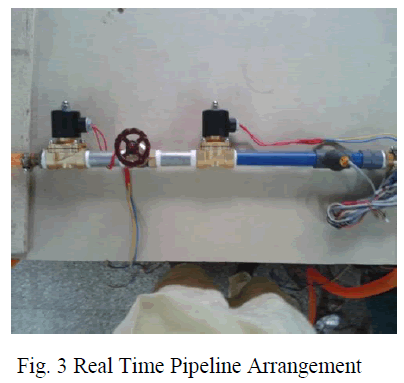 |
| The Fig. 3 shows the real time pipeline arrangement, it has two solenoid valve (one input side and another near output side), turbine flow sensor. It has been implemented with one node. |
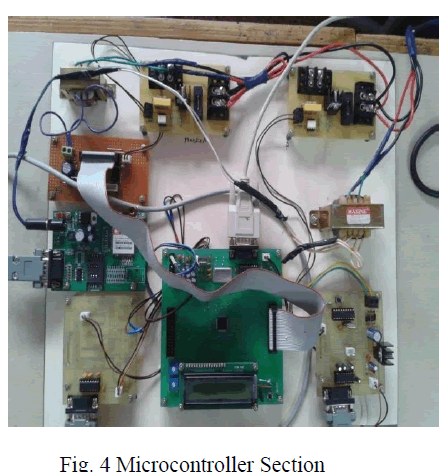 |
| The Fig. 4 shows the microcontroller section of the proposed system. It has a TRIAC switch, controller section and a GSM modem. In a case if a theft is occurred then the controller will send a signal to the TRIAC circuit to close the solenoid valve nearby that node. Then a message will sent using the GSM to the officer mobile indicating about the theft and where the theft occurs. |
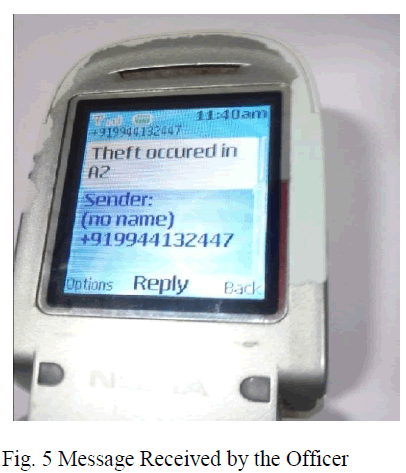 |
| The Fig. 5 shows the message that has been sent to the officer mobile. |
VI. CONCLUSION |
| The automated system implemented into the water distribution network insures the update of the refurbished water supply urban utilities; it offers new ways of monitoring and optimized exploitation of the water resources and technological equipments. A wireless monitoring system of urban water supply based on the ARM7 microprocessor is designed. It takes full advantage of low-power and ARM7 microprocessor; these features make this system work in harsh industrial site properly. At the same time, the use of embedded operating system μC/OS-II makes this system more coherent and concise. This automated system not only used to monitor the water supply but also used to find and avoid the water theft. |
References |
|